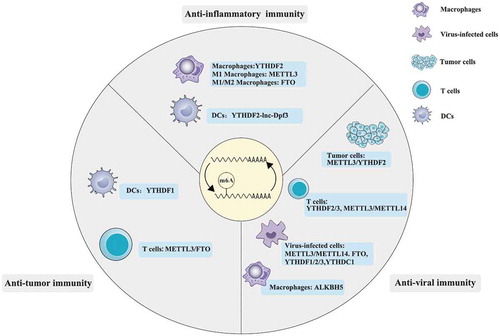Figures & data
Table 1. The interplay between m6A and innate and adaptive immune cells
Figure 1. The descriptions of innate immunity and adaptive immunity. Innate immunity and adaptive immunity are two main types of mammalian immune system, with the innate immune response as the first line of defence and protection, which primes and amplifies subsequent adaptive responses. Dendritic cells and macrophages are identified as important antigen-presenting cells (APCs) owing to their efficient ability to internalize pathogen and present pathogen peptides. T cells are generally classified into two groups expressing either cell surface CD4 or CD8 receptors. CD4 T cells are commonly referred to as helper T cells owing to their contribution to cytokine response. The activated CD4 T cells support the action of B cells to produce lots of antibodies. Once the same antigen infects the body again, memory B cells are stimulated to differentiate into effector B cells (plasma cells) to secrete large amounts of antibodies. The CD8 + T cells can be activated by the stimulation of cognate antigen and effector T cells can directly induce death in infected target cells. Meanwhile, a small group of memory T cells are left after antigen clearance

Figure 2. The involvement of m6A in the regulation of anti-inflammatory, anti-viral and anti-tumour immunity

Table 2. Summary of viral RNA and DNA regulation by m6A
